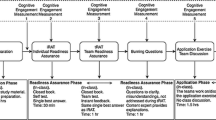Abstract
The purpose of the present study was both to extend the performance optimality hypothesis of action identification theory to the realm of education and to examine the indirect role of action identification levels and action maintenance difficulty on the relationship between initial and final performance. Results demonstrated that students’ final performance is related to their initial performance and that this relationship is mediated by the way they identify the action of “attending a class”, which is itself inconsistently mediated by action maintenance difficulty. These findings pave the way for new educational applications in order to improve students’ academic performance.
Similar content being viewed by others
References
Aiken L. S., West S. G. (1991) Multiple regression: Testing and interpreting interactions. Sage, Newbury Park, CA
Arbuckle, J. L. (2005). Amos 6.0 user’s guide. Chicago: SPSS.
Bandura A., Schunk D. H. (1981) Cultivating competence, self-efficacy, and intrinsic interest through proximal self-motivation. Journal of Personality and Social Psychology 41(3): 586–598. doi:10.1037//0022-3514.41.3.586
Betts L. R., Elder T. J., Hartley J., Blurton A. (2008) Predicting university performance in psychology: The role of previous performance and discipline specific knowledge. Educational Studies 34(5): 543–556. doi:10.1080/03055690802288528
Beukeboom C. J., Semin G. R. (2005) Mood and representations of behavior: The how and the why. Cognition & emotion 19(8): 1242–1251. doi:10.1080/02699930500203369
Dar R., Katz H. (2005) Action identification in obsessive-compulsive washers. Cognitive Therapy and Research 29((3): 333–341. doi:10.1007/s10608-005-4266-5
French Minister of research and University. (2007). Plan pluri-annuel pour la réussite en licence. Retrieved on December, the 12th, 2011 from http://media.enseignementsup-recherche.gouv.fr/file/Communiques/01/8/orientationlicence_21018.pdf.
Hu L., Bentler P. M. (1999) Cutoff criteria for fit indexes in covariance structure analysis: Conventional criteria versus new alternatives. Structural Equation Modeling 6(1): 1–55. doi:10.1080/10705519909540118
Hunt, G. W., & Hoyer, W. D. (1993). Action identification theory: An examination of consumers behavioral representations. In L. M. McAlister & M. L. Rotschild (Eds.), Advances in consumer research (Vol. 20, pp. 449–454).
Liberman N., Trope Y. (1998) The role of feasibility and desirability considerations in near and distant future decisions: A test of temporal construal theory. Journal of Personality and Social Psychology 75(1): 5–18. doi:10.1037/0022-3514.75.1.5
MacKinnon D. P., Fairchild A. J., Fritz M. S. (2007) Mediation analysis. Annual Review of Psychology 58: 593–614. doi:10.1146/annurev.psych.58.110405.085542
Pintrich P. R., Schunk D. H. (2002) Motivation in education: Theory, research, and applications (2nd ed.). Merrill-Prentice Hall, Columbus, OH
Trope Y., Liberman N. (2003) Temporal construal. Psychological Review 110(3): 403–421. doi:10.1037/0033-295X.110.3.403
Trope Y., Liberman N., Wakslak C. J. (2007) Construal levels and psychological distance: Effects on representation, prediction, evaluation, and behavior. Journal of Consumer Psychology 17(2): 83–95. doi:10.1016/S1057-7408(07)70013-X
Vallacher R. R., Wegner D. M. (1985) A theory of action identification. Lawrence Erlbaum Associates, Hillsdale, NJ
Vallacher R. R., Wegner D. M. (1987) What do people think they’re doing? Action identification and human behavior. Psychological Review 94(1): 3–15. doi:10.1037//0033-295X.94.1.3
Vallacher R. R., Wegner D. M. (1989) Levels of personal agency: Individual variation in action identification. Journal of Personality and Social Psychology 57(4): 660–671. doi:10.1037/0022-3514.57.4.660
Vallacher R. R., Wegner D. M., McMahan S. C., Cotter J., Larsen K. A. (1992) On winning friends and influencing people: Action identification and self-presentation success. Social Cognition 10(3): 335–355. doi:10.1521/soco.1992.10.3.335
Vallacher R. R., Wegner D. M., Somoza M. (1989) That’s easy for you to say: Action identification and speech fluency. Journal of Personality and Social Psychology 56(2): 199–208. doi:10.1037//0022-3514.56.2.199
Wegner, D. M., Connally, D., Shearer, D., & Vallacher, R. R. (1983a). Disruption and identifications of the act of eating. Research Data (unpublished).
Wegner, D. M., Kyser, G., & Vallacher, R. R. (1983b). Identification of the act of using glaucoma medication. Research data (unpublished).
Wegner, D. M., Richard, M. & Vallacher, R. R. (1982). Identification of the act of rearing a child. Research Data (unpublished).
Wegner, D. M., & Vallacher, R. R. (1983). Action identification level and maintenance indicators ratings. Research Data (unpublished).
Wegner D. M., Vallacher R. R., Dizadji D. (1989) Do alcoholics know what they’re doing? Identifications of the act of drinking. Basic and Applied Social Psychology 10(3): 197–210. doi:10.1207/s15324834basp1003_1
Wegner, D. M., Vallacher, R. R., Ewert, J., & Reno, L. (1983). Knowing what one is doing: Action identification and self-control. Trinity University (unpublished manuscript).
Wegner D. M., Vallacher R. R., Kiersted G., Dizadji D. (1986) Action identification in the emergence of social behavior. Social Cognition 4(1): 18–38. doi:10.1521/soco.1986.4.1.18
Woolley A. W. (2009) Putting first things first: Outcome and process focus in knowledge work teams. Journal of Organizational behavior 30(3): 427–452. doi:10.1002/job.578
Woolley A. W. (2009) Means versus ends: Implications of outcome and process focus for team adaptation and performance. Organization Science 20(3): 500–515. doi:10.1287/orsc.1080.0382
Author information
Authors and Affiliations
Corresponding author
Rights and permissions
About this article
Cite this article
Mange, J., Sénémeaud, C. & Michinov, N. Jotting down notes or preparing for the future? Action identification and academic performance. Soc Psychol Educ 16, 151–164 (2013). https://doi.org/10.1007/s11218-012-9205-3
Received:
Accepted:
Published:
Issue Date:
DOI: https://doi.org/10.1007/s11218-012-9205-3




